Clearnose Skate
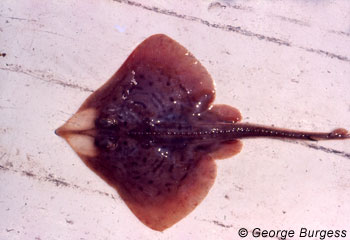
Raja eglanteria
This diamond-shaped skate is generally a brown to gray color with darker spots and bars and some irregular lighter shapes. It is named for the translucent areas on either side of its rostral ridge, the triangle of its pointed snout.
These skates live in the northwestern Atlantic, migrating inshore and out to deeper water with the seasons. It is harmless to humans, and because it adapts well to captivity, it is popular in aquariums and research facilities.
Order: Rajiformes
Family: Rajidae
Genus: Raja
Species: eglanteria
Common Names
R. eglanteria is commonly referred to as the clearnose skate in the U.S. Other names include: clear-nose brier skate (English), clear-nose summer skate (English), pinokkiorog (Dutch), raia-focinho-branco (Portuguese), raie blanc nez (French), and raya hialina (Spanish).
Importance to Humans
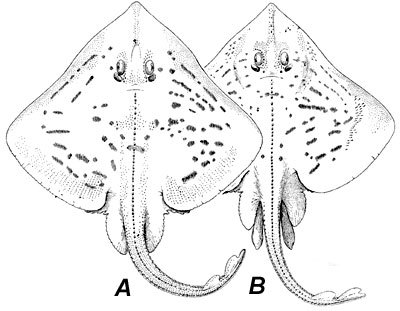
While not traditionally a commercially targeted species, it is regularly caught as by-catch. Due to its tendency to be near shore, this species is often caught by recreational fishers. This species is often used in biomolecular research due to its relative ease of capture and its ability to live in captivity.
Danger to Humans
Danger to humans is extremely low. Skates lack spines like those found on stingrays, but do possess many thorns. These thorns could injure a person if they stepped on or picked up a skate.
Conservation
> Check the status of the clearnose skate at the IUCN website.
The IUCN is a global union of states, governmental agencies, and non-governmental organizations in a partnership that assesses the conservation status of species.
Geographical Distribution
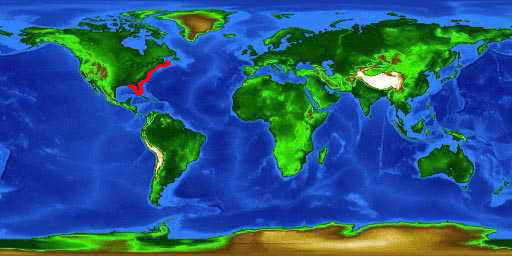
The clearnose skate is found, in the western north Atlantic, from Massachusetts to south Florida. This skate is also common in the eastern part of the Gulf of Mexico. It has also been known to range north along the Canadian coast.
Habitat
In many parts of its range R. eglanteri a is considered the most common skate in the area. The clearnose skate is commonly caught in inshore waters but may move offshore during the colder months.
R. eglanteria is only a warm season visitor in the northern parts of its range, migrating south during the fall and winter. This skate has been caught in salinities ranging from 12ppt to 35ppt and temperatures from 43.3°F (6.3°C) to 80.6°F (27°C).
Biology
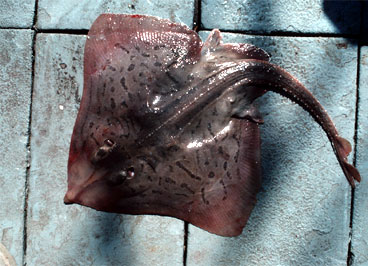
Distinctive Features
The clearnose skate is characterized by the presence of a single row of thorns along the mid-ridge of its dorsal side from the shoulders to the tail. There are two dorsal fins located on the posterior end of the tail. The presence of small dark spots and bars with no ocellar spots on the dorsal side is also distinctive.
Coloration
The dorsal surface of R. eglanteria is usually dark or light brown or gray with many darker round spots and bars present. Often there are irregular spots of lighter pigmentation present on the upper surface as well. As its name suggests there are translucent spaces on either side of the rostral ridge. The ventral surface is white and lacks any markings.
Dentition
The clearnose skate has between 46 and 54 upper teeth and around 48 lower teeth. Their teeth are close-set and exhibit low conical cusps. R. eglanteria dentition is sexually dimorphic, with males exhibiting sharper teeth than females, presumably to enable a better grip of the female during copulation.
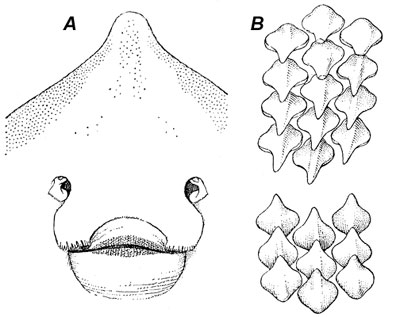
Size, Age, and Growth
The clearnose skate may reach a maximum disc width of 18.9 inches (48cm) and a maximum length of 33 inches (84cm). It is thought that male skates of this species mature at 29.5 inches (75cm) total length while females mature at 29.9 inches (76cm) total length.
Food Habits
Mollusks, shrimp, crabs, and small fish are the dominant food items eaten by the clearnose skate. One study found the following prey items in the stomach of clearnose skates: blackcheek tongue fish (Symphyrus plagiusa), striped anchovies (Anchoa hepsetus), croaker (Micropogonias undulatus), spot (Leiotomus xanthurus), mantid shrimp (Squilla empusa), white shrimp (Penaeus azetecus), and squid (Loliguncula brevis).
Reproduction
During copulation, the male will bite the caudal margin of the female’s pectoral fin and bend his tail beneath hers. The male will then flex one clasper 90° into her cloaca. Thorns on the upper anterior surface of the male’s pectoral fins are thought to assist in holding the female. Mating in captivity has been observed to last from one to four hours. Females store sperm in the upper portion of the shell gland where they may be viable for at least three months.
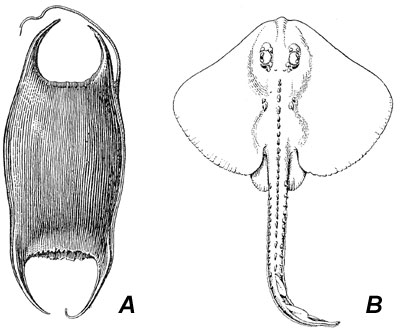
R. eglanteria, like all skates, is oviparious. Eggs, often called “mermaids purses,” are usually laid in multiple pairs at intervals ranging from 1 to 13 days. Eggs range in size from 2 to 3.5 inches (5cm to 8.9cm) long and 1.5 to 2.25 inches (3.8cm to 5.7cm) wide. In Florida, eggs are laid from December through May. A single female may lay up to 66 eggs in one season.
Egg incubation is thought to last at least three months but may decrease later in the season. Newly hatched skates have a disc width between 3.3 to 4.1 inches (8.4cm to 10.5cm) and total length between 5.1 to 5.9 inches (13cm and 15cm). Scientist have noted that clearnose skate eggs fail to develop in water warmer than 75.2°F (24°C).
Predators
Any large carnivorous fish, such as the sand tiger shark, is a potential predator of the clearnose skate.
Taxonomy
The clearnose skate is a member of the single skate family, Rajidae. Bosc (1802) described this skate as Raja eglanteria. The genus name is derived from the Latin “raja, -ae” = a sting ray. Junior synonyms include Raja diaphanes Mitchill 1815,Raja chantenay Lesueur 1824, and Raja desmarestia Lesueur 1824.
Prepared by: Andrew Piercy